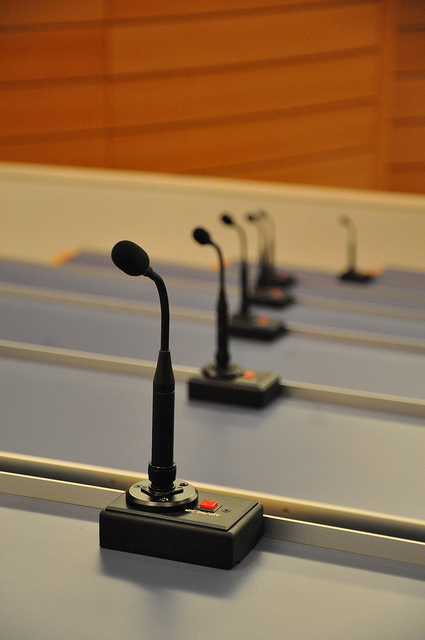 While the propriety of video and photography equipment in federal courts is subject of ongoing debate and testing,
a number of federal bankruptcy courts and three federal district courts
make audio recordings of their proceedings available to the
public for a nominal fee.
While the propriety of video and photography equipment in federal courts is subject of ongoing debate and testing,
a number of federal bankruptcy courts and three federal district courts
make audio recordings of their proceedings available to the
public for a nominal fee.
In his article for The New York Times "Room for Debate" feature on whether courts should eliminate human court reporters (spurred by the chaos caused by the recent resignation of a drug-addicted court reporter in New York), U.S. District Court Judge Richard G. Kopf casually mentions that proceedings in his court in Lincoln, Nebraska, are routinely audio recorded. The recordings are posted to the court's public online PACER database the same day.
PACER, short for Public Access to Court Electronic Records, is the federal courts' online case docket access system. Access to PACER requires registration, and fees are charged for accessing materials in the database.
On his blog -- a federal judge with a blog! -- Kopf explained last year that his court had been recording its proceedings "for a long time now," i.e., since 2007.
After an initial one-year test of audio recording technology in 12 federal district and bankruptcy courts, the U.S. Judicial Conference approved digital audio recordings as a method of taking the official record of court proceedings in September 1999. Compact discs of the recordings were made available to the public from the courts' clerk's offices, for a $26 fee.
In 2007 and 2008, five federal courts -- three trial courts and three bankruptcy courts -- began a pilot project of offering the audio recordings on PACER. The success of the program led to its expansion in 2009 to two additional bankruptcy courts and the U.S. Court of Federal Claims (which offers the recordings for selected cases through its website: example). In 2010, the program was opened to all federal courts, and the cost to access the recordings was raised from 8 cents to $2.40. This led 22 additional bankruptcy courts to implement the program.
Now, a total of 32 trial and bankruptcy courts offer audio recordings online.
In addition to the Court of Federal Claims, the trial courts include three federal district courts: the U.S. district courts in Nebraska -- Kopf's court -- the Eastern District of Pennsylvania, and the Southern District of Alabama (although it appears to have posted only one audio file).
The remaining 28 courts offering the recordings on PACER are federal bankruptcy courts : the U.S. bankruptcy courts for the Northern District of Alabama; District of Alaska, Northern District of California, District of Connecticut, Middle District of Florida, District of Hawaii, Central District of Illinois, Southern District of Indiana, District of Maine, Eastern District of Michigan, District of Minnesota, Eastern District of Missouri, Eastern District of North Carolina, Middle District of North Carolina, District of Nebraska, District of New Mexico, District of Nevada, District of New Jersey, Southern District of New York, District of Puerto Rico, District of Rhode Island, District of Utah, District of Vermont, Eastern District of Washington, Northern District of West Virginia, Southern District of West Virginia, Eastern District of Wisconsin, and the District of Wyoming.
The PACER system also offers an instructional video -- featuring a talking gavel -- on how to access the audio files in the PACER system.
At the appellate level, most of the federal Courts of Appeals offer audio recordings of their oral arguments on their websites, outside of PACER (1st; 3rd; 4th; 5th; 6th; 7th; 8th; 9th; D.C.; Fed.). Even the U.S. Supreme Court -- which has stubbornly resisted audio-visual coverage, despite pressure and a recent breach of this protocol -- posts audio of arguments to its website at the end of each week (while releasing transcripts of all cases and audio of a few prominent cases on the same day they are argued).
It's interesting that while the number of bankruptcy courts offering recordings has continued to grow, the number of federal trial courts offering the recordings has not increased significantly beyond the three that were in the program at its inception. Of course, trial courts are more likely than bankruptcy courts to have proceedings of interest to the press and the general public.
The audio recordings in the federal trial and bankruptcy courts are part of a larger debate over the merits of human court reporters. But as a court access issue, the easy and inexpensive availability of audio recordings of court proceedings is an important development, which hopefully more courts will embrace.
Eric P. Robinson is co-director of the Program in Press, Law and Democracy at the Manship School of Mass Communication at Louisiana State University. He has taught media law and ethics at the CUNY Graduate School of Journalism, Baruch College, and the University of Nevada, Reno, where he was also Deputy Director of the Donald W. Reynolds Center for Courts and Media. He has also been a staff attorney at the Media Law Resource Center and a legal fellow at the Reporters Committee for Freedom of the Press. In addition to his posts here, he maintains his own blog at bloglawonline.com.
(Image courtesy of Flickr user Derek K. Miller pursuant to a Creative Commons CC BY-NC 2.0 license.)




